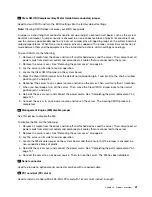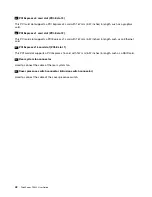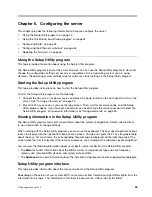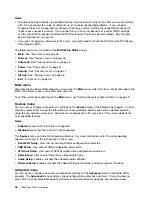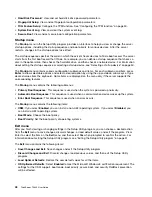
• View information about all server models supported by the ThinkServer EasyStartup program and
information about the device drivers for each server model, including the driver versions and driver
locations in the root directory of the
ThinkServer EasyStartup
DVD.
Note:
The most up-to-date device drivers for various server models are always available for download on
the Lenovo Support Web site at:
http://www.lenovo.com/drivers
Configuring RAID
This topic provides information about RAID and the utility programs that are available for you to configure
RAID.
This topic contains the following items:
•
“About RAID” on page 55
•
“RAID for your server” on page 56
•
“Configuring the system BIOS to enable onboard SATA RAID functionality” on page 57
•
“Configuring the advanced SATA or SAS hardware RAID” on page 58
About RAID
RAID, an acronym for Redundant Array of Independent Disks, is a technology that provides increased
storage functions and reliability through redundancy. This is achieved by combining multiple hard disk drives
into a logical unit, where data is distributed across the drives in one of several ways called RAID levels.
When a group of independent physical hard disk drives are set up to use RAID technology, they are in a
RAID array. This array distributes data across multiple hard disk drives, but the array appears to the host
server as one single storage unit. Creating and using RAID arrays provides high performance, such as the
expedited I/O performance, because several drives can be accessed simultaneously.
RAID drive groups also improve data storage reliability and fault tolerance compared to single-drive storage
systems. Data loss resulting from a drive failure can be prevented by reconstructing missing data from the
remaining drives.
The following list describes some of the most commonly used RAID levels:
•
RAID 0
: block-level striping without parity or mirroring
Simple stripe sets are normally referred to as RAID 0. RAID 0 uses striping to provide high data
throughput, especially for large files in an environment that does not require fault tolerance. RAID 0 has no
redundancy and it provides improved performance and additional storage without fault tolerance. Any
drive failure destroys the array and the likelihood of failure increases with more drives in the array. RAID
0 does not implement error checking, so any error is uncorrectable. More drives in the array means
higher bandwidth, but greater risk of data loss.
RAID 0 requires a minimum number of two hard disk drives.
•
RAID 1
: mirroring without parity or striping
RAID 1 uses mirroring so that data written to one drive is simultaneously written to another drive. This is
good for small databases or other applications that require small capacity but complete data redundancy.
RAID 1 provides fault tolerance from disk errors or failures and continues to operate as long as at least
one drive in the mirrored set is functioning. With appropriate operating system support, there can be
increased read performance and only a minimal write performance reduction.
RAID 1 requires a minimum number of two hard disk drives.
Chapter 5
.
Configuring the server
55
Summary of Contents for ThinkServer TS440
Page 1: ...ThinkServer TS440 User Guide Machine Types 70AL 70AM 70AN and 70AQ ...
Page 16: ...4 ThinkServer TS440 User Guide ...
Page 18: ...6 ThinkServer TS440 User Guide ...
Page 56: ...44 ThinkServer TS440 User Guide ...
Page 74: ...62 ThinkServer TS440 User Guide ...
Page 166: ...154 ThinkServer TS440 User Guide ...
Page 176: ...164 ThinkServer TS440 User Guide ...
Page 181: ......
Page 182: ......

